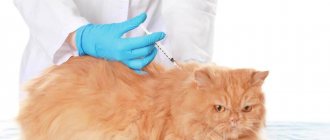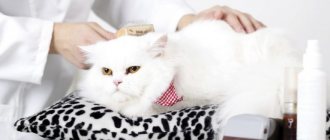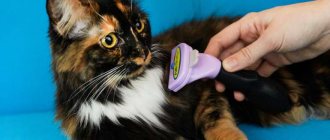Home » Useful Information
The question “How to wash a cat?” Sooner or later, every cat owner asks himself. This is not an easy matter. To carry out bathing procedures effectively and with minimal risk for both parties, it is important to know some rules.
- 2 When and how often should cats be bathed?
- 3 How and with what to properly wash a cat
- 4 Is it possible to wash a cat with products that people use?
- 5 What to do if your cat is afraid of water
- 6 How to dry an animal
- 7 Important points to remember when washing your cat
7.1 Video: How to wash a cat? Everything will work out even with evil cats
Why do cats hate water so much?
The fear of water is inherent in representatives of the cat family genetically, by nature itself. The fact is that the animal’s fur contains a special layer of air that has the ability to retain heat. When cats' fur gets wet, they begin to freeze.
Do not forget that a cute pet is a hunter by nature. And wet fur emits a specific, noticeable odor that can scare away potential prey.
And some more tips on washing cats
- Do not bathe a pregnant cat or if she is nursing kittens.
- An adult, unneutered cat needs more frequent washing. Due to the secretion secreted, his fur gets dirty faster, becomes greasy and sticks together.
- At least two weeks must pass after the operation, and only then can the animal be bathed.
- If you adopted a pet from a shelter, you should not wash it in the first few days. Moving and swimming together is incredibly stressful.
- During the shedding period, washing helps to quickly get rid of dead hairs.
- Do not wash your animal while it is sick.
So, the frequency of bathing is a conditional indicator. It depends on the cat’s cleanliness, the characteristics of its lifestyle and conditions of detention. An attentive owner will always understand that his pet needs additional care and will carry out water procedures with maximum comfort. For professional haircuts and grooming, we recommend going to a pet salon.
Why you need to wash your cat
Many owners wonder: does their pet need water treatments at all? After all, cats are very clean, regularly lick themselves, and clean up their own mess. However, veterinary experts say that bathing is necessary even for domestic cats that do not leave the apartment.
The fact is that a pet can catch pathogenic bacteria even through contact with street clothes and shoes of its owners who come to the guests' house. Therefore, bathing is a necessary hygienic procedure, which is important not only for the appearance, but also for the good health of the pet.
When swimming is contraindicated
As you know, cleanliness is the key to health. But there are times when water treatments need to be postponed.
- First of all, focus on the animal’s well-being; if the kitten is sick, you cannot wash it.
- Unhealed wounds on the skin are another reason to postpone the procedure.
- After vaccination, the animal cannot be bathed for two weeks, after castration - for 10 days.
- Age under four weeks is a relative contraindication.
- If a kitten did not come into your home from the street, you can bathe it only after three weeks of adaptation.
- But for shingles, bath procedures are welcome.
If you carry out the first procedure carefully, without damaging the delicate mental organization of your pet, subsequently bathing will not cause negative emotions in him. And perhaps he will even love to swim. And then keeping your pet clean will not be a problem for you.
How often are water procedures carried out?
The frequency of bathing a cat depends on many factors. For example, long-haired cats or pets that walk outside and come into contact with other animals should be washed more often.
The basic rule is to carry out water procedures no more than once every 3 months to avoid drying out the skin, deteriorating the condition of the coat and the appearance of dandruff.
The main indications for emergency bathing of a cat:
- preparation for participation in the exhibition;
- parasitic pathogens on the skin and hair;
- severely soiled wool.
On average, it is recommended to wash your pet about 3-4 times a year. For cats of long-haired breeds, pets that actively take part in various exhibitions, these figures increase up to 5-6 times.
At the same time, experts recommend taking into account the breed of the animal, its general health and individual attitude to the bathing process, the degree of severity of its psycho-emotional reactions during washing and contact with water.
When to bathe a cat?
It is worth noting that the procedure for putting a cat in order differs from water manipulations carried out with dogs. This is due to the fact that they have different coats, as well as different walking procedures and mechanisms. If a dog walks outside several times a day, many cats spend almost most of their time at home. If your pet is like this, then there is no point in bathing it very often. When is it necessary to bathe cats?
Indications for swimming:
- First of all, you need to pay attention to the smell. If it is strong, the cat is in heat, or the cat at home often marks the territory, then we advise you to bathe your pet in this case.
- If you notice parasites on the surface of the fur. That is, the cat has fleas.
- And the third option is preventive. That is, from time to time, even if your cat does not walk outside, he needs to be washed.
Bathing a cat
How to teach a cat to bathe
In order for your pet to accept water procedures normally and not be afraid of water, you need to start accustoming him to them from a very early age. According to veterinarians, it is not recommended to wash the kitten until its milk teeth have been replaced by molars. But slowly accustoming the baby to water by dipping the baby’s paws into it is a completely suitable procedure.
A month after the kitten’s last molar grows, you can give it a full bath for the first time. This way, the process of adaptation to water will be easier, and in the future, hygiene procedures will not cause serious psycho-emotional shocks for the cat when it grows up.
In addition, it is worth accustoming the kitten to the bath itself so that it does not feel afraid of it. To do this, you need to periodically put the baby in the bathtub and give him some toys.
Instructions for bathing a kitten
The main principle that should be followed when washing your baby is not to scare him. This is especially important for 3-month-old kittens. The first procedure affects the subsequent attitude towards water. The resulting negative experience can permanently discourage the desire to swim.
Step 1. Preparatory stage
Due to the fact that cats perfectly recognize the emotional state of the owner, you should relax before bathing. The owner's nervous mood is transferred to the animal.
General recommendations:
- Check that there are no drafts in the bathroom.
- Cover your baby's ear canals with cotton balls. Getting water into the ears can lead to colds. It is advisable to lubricate the corners of the eyes with Vaseline. This will help prevent shampoo from getting on mucous membranes.
- Trim the animal's claws and brush it. If there are tangles, they need to be removed.
- Prepare a towel, gloves, shampoo, conditioner, your kitten's favorite toys and, if necessary, a basin.
It is better to prepare for this event on your own, without the presence of the kitten.
Your pet's overgrown nails should be trimmed before bathing.
Step 2. Selecting a container
A large bath is not suitable for washing a kitten. It is better to use a basin or sink. During the procedure, the baby should stand on his feet and not swim. In addition, it is easier to hold it in a small container. To prevent the paws from sliding on the surface, the bottom should be covered with a rubber mat.
Step 3. Water procedure
When immersing a kitten in water, you should make sure that it does not rise above the shoulder line. The optimal temperature is from 36 to 39°C. It is necessary to hold the baby tightly to prevent him from jumping out. During this event, it is advisable to constantly talk to your pet and distract him with rubber balls, soap bubbles and other improvised means.
Basic Rules:
- Dilute shampoo and conditioner not on the animal’s fur, but in a separate container.
- Carefully remove the foam formed on the hair using a special brush.
- Do not spray your baby with tap water or shower water. It is preferable to rinse from a mug.
- Pay special attention to the areas behind the ears, on the paws, groin, anus and abdominal area. The most dirt accumulates in these parts.
- Apply water to the kitten's head using a sponge. This will prevent water from getting into your ears.
- Rinse off detergents thoroughly. Otherwise, the animal may be poisoned. To wash away the smell of care products, cats lick themselves thoroughly after washing. If shampoo left on the fur gets into the digestive tract, it will cause stomach upset.
- If the pet is very dirty, before bathing, grease the stain with butter and blot it with a napkin.
- When using anti-parasitic flea products, the neck should be blotted first. This helps prevent insects from migrating to the head.
- If there is a need to wash individual parts of the body, use wet wipes, a towel and spray shampoos.
At the end of the procedure, reward your baby with his favorite treat.
A cat's body temperature is 38 degrees, so the water temperature should not be more than 39°C
Step 4. Drying the wool
At the end of the procedure, you need to blot with terry cloth and wrap in a softer towel. This will help avoid the occurrence of colds. You should not rub your pet, as there is a risk of tangles forming. To prevent your pet from getting sick, he should spend the next 12 hours in a warm room. Staying in the fresh air is not advisable.
Some babies love to blow dry their hair. However, this device is only suitable for long-haired breeds. During the drying process, comb the hair. This prevents the fur from tangling and removes dead hair.
If a kitten trembles for more than 5 minutes after bathing, regardless of breed, it should be dried with a hairdryer. Otherwise, pneumonia may develop.
Signs of pneumonia in cats
Basic rules for bathing a cat
To make the bathing process as comfortable as possible for both the owner and the pet, the following recommendations must be taken into account:
- Use special shampoos designed for cat hair, which can be purchased at pet stores. It is forbidden to wash your pet with hair products or shampoos for dogs, as this can cause problems with the skin and cause a number of allergic reactions.
- Before bathing, thoroughly comb the animal's fur and, if there are tangles, untangle or carefully cut them out.
- Cover the bathroom with a rug. Many animals are stressed not only by water, but also by the slippery, uncomfortable surface under their paws.
- Use warm water and fill it into a container so that it covers only half of the animal's body.
- You can wash your pets not in the bathtub, but in the sink; it is more compact and less intimidating.
- Do not use a shower, as strong water pressure is very stressful for the animal. It is best to wash your pet by hand or gently rinse it out of a ladle.
- Prepare everything necessary for hygiene procedures in advance so as not to be distracted when the animal is in the water and not to prolong the unpleasant bathing process.
- Wash the animal with massage movements, foaming the shampoo before applying it to the fur.
- Make sure that soap suds and water do not get into your pet’s eyes and ears.
You should not delay the bathing process and act as quickly as possible so as not to expose the animal to unnecessary stress. You should try to keep it to a maximum of 5-6 minutes.
In this case, it is advisable to use an assistant. If one person holds the pet, and the second soaps and washes it, then the whole procedure is much easier and faster.
Important points to remember when washing your cat
A good owner must know and take into account the physiology of his pet. This also applies to the issues of his bathing:
- you should refrain from unnecessarily frequent bathing procedures, because due to the systematic removal of the natural fatty film, the natural protection of the pet’s skin and coat is disrupted;
- You should not bathe an animal that has recently eaten. At least three hours should pass from eating to bathing;
- representatives of long-haired breeds are recommended to be combed before washing;
- under no circumstances should the animal be allowed to be immersed in water with its head;
- If the cat has stained its paws with resin or paint, you should wipe them with a piece of soft cloth soaked in olive oil, and then rinse them with water and shampoo.
Proper care of your furry family member will help you avoid mistakes that could negatively affect his health.
How to dry a cat correctly
After finishing bathing, you should dry the cat thoroughly with a towel and place it in a warm place to dry. It is important that there are no drafts in the room to prevent your pet from catching a cold. But often the animal, being in a panic, begins to rush around the entire apartment. In this case, you should take your pet in your arms and wrap it in a warm blanket. Holding your cat may be difficult, but he will soon warm up and fall asleep peacefully.
At this time, you should try not to wake the animal. When it wakes up, firstly, it will already be partially dry, and, secondly, the stress factor will decrease. After this, you can try to dry the cat using a hairdryer. Many furry pets even enjoy this process. If not, then you should not subject the animal to new tests; it is better to let it dry naturally.
How to bathe cats at home: preparation
Before you start bathing, prepare the bath. Place a rubber mat or towel on the bottom so that the cat does not slip and is comfortable to stand on. After washing, the floor will be wet, so place rags on the floor to absorb the water.
Draw water
Before you bring your pet into the bathroom, fill the bathtub with warm water (35‒39℃). Under no circumstances should it be hot; boiling water will not only burn the animal, but will also instill fear of washing forever. There should not be a lot of water so that the cat does not drown.
Do not run a bath in front of your pet if running water makes him nervous. In this case, collect water in large pots (tanks) in advance.
Prepare 2 towels
Leave 2 terry towels in the bathroom in advance, which absorb water well.
Wear protective clothing
Before bathing your pet, wear protective clothing. A long-sleeved shirt and pants will save you from small and large scratches. Elbow-length gloves are also an option, but they may be uncomfortable to swim in.
What to do if your cat is afraid of water
There are times when a cat is terrified of water. Then bathing turns into extreme stress for him, and the owners run the risk of getting more scratches and bites even from the most affectionate and calm pet. In this situation, dry shampoo for cats will come to the rescue.
The product in powder form must be applied to the pet’s fur, and then combed thoroughly with a comb. Dry shampoo does not cause allergic reactions, allows you to avoid contact with water and at the same time copes well with fat and various types of contaminants.
Maintenance and hygiene of cats
The cat is characterized as a clean and tidy animal that regularly performs hygienic care for its fluffy fur. But, due to physiological characteristics, not all parts of the body are accessible to the pet, so her beloved owner comes to her aid.
It so happens that cats, by natural instinct, are very afraid of water. And if some representatives of the genus tolerate bathing procedures more loyally, others create a real problem for their owners. At the sight of a basin of water, the cat begins a real battle: it tries with all its might to escape from the person’s hands, scratches, bites and has absolutely no control over its actions.
To calm down the furious ardor of a frightened animal, one has to use physical force, which is not very correct in relation to it. Is it possible to wash a cat in a calm environment, without violent actions towards it and injuries in the form of bites and scratches on the owner?
Some people believe that this is impossible, but this opinion is wrong! If you follow the recommendations of specialists, you can quickly accustom your pet to bath procedures and make them enjoyable for the animal. We will tell you how to do this further!
Emergency methods
In extreme cases, when an animal shows aggression and flatly refuses hygiene procedures, and the owner definitely needs to give it a bath, you can resort to emergency methods. For these purposes, you will have to purchase a special suction cup mount at the pet store.
The suction cup itself is attached to the wall of the bathtub, and the loop attached to it is placed around the cat’s neck. You should not worry about the safety of your pet. The product is made in such a way that, while fixing the cat, it does not choke it, providing the opportunity, in a pinch, to wriggle out of the loop.
Then you can calmly move on to the bathing process. For long-haired cats, in addition to shampoo, it is recommended to use a special degreasing paste. This product is applied to dry wool, left for 5-6 minutes, after which it is carefully washed off with warm water.
At the end of the procedure, you can use a balm for cats to avoid drying out the skin, making your pet’s coat especially beautiful and giving it a healthy shine. In addition, balms help prevent the appearance of dandruff.
Before the exhibition
To enhance the color of the coat, a tinted shampoo of blue, red or black colors is often used, depending on the color of the animal. For white cats, a lightening agent is used, sometimes several times in a row.
To enhance the shine of wool, there are special products: balms, conditioners and oils.
Types of cat shampoos
You can only wash your cat using shampoo specifically designed for this purpose.
Pet stores offer a fairly wide selection of products, and many owners are simply lost, what to choose? When choosing a shampoo, you should take into account the breed of your pet, the condition of its coat and other factors. All cat bathing products can be divided into the following main categories:
- Powder shampoo is a dry powder that is great for animals that are terrified of water. Owners of long-haired pets can periodically use this product for preventive purposes to maintain a well-groomed appearance for their pet. Powder shampoos are especially helpful before shows, when you need to quickly get your cat in order.
- Spray is an innovative product similar in effect to dry shampoos. The spray is also sprayed onto dry hair and then combed out. This product copes well with dirt, removes grease, adds shine and has a pronounced antistatic effect.
- Traditional cat shampoos are rightly considered the most effective detergent. They facilitate the combing process and allow you to get rid of the most severe dirt, which other analogues are powerless to combat. In addition, the market offers shampoos intended for cats of various breeds, products with an anti-flea effect, and a line of antiparasitic products.
Thus, each owner can choose the best shampoo option for their pet, especially since this type of product is presented in different price categories.
Also watch the video on how to wash a cat:
Bathing a cat with fleas
Cats with fleas require special care. There are different shampoos and methods for cats of different ages, let's look at how to wash your pet against fleas:
1 month. It is best to use tar soap or baby shampoo. The water temperature should be 38 degrees. Do not wet the cat's face. As soon as the fleas move there, start combing it out with a toothbrush.
2 months. You can use special products designed for this age. Dilute the shampoo in water in a ratio of 1 ml per 400 ml. water. Apply the product to the coat and wait 5-7 minutes. Field of which you can wash off the solution.
- What to give your beloved husband something unusual for his birthday. List of ideas + video
- Can a non-owner of a car apply for compulsory motor liability insurance?
Radon baths: indications and contraindications, reviews from doctors, benefits and harms, rules of administration
3 months and older. You can use different anti-flea products. To avoid making a mistake with your choice, consult your veterinarian.
The use of anti-flea shampoos is not permissible if the kitten is near its mother.
Thus, water treatments for cats are very useful and help them maintain beauty and health.











